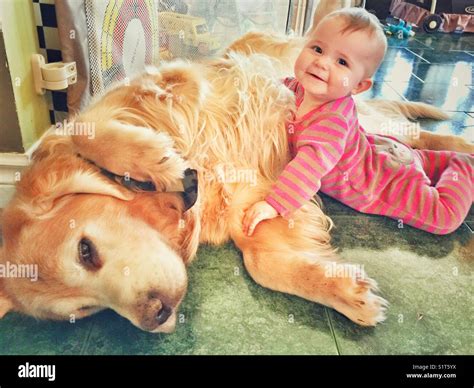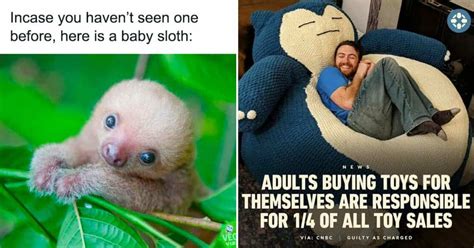
A golden retriever is captivating hearts online by seemingly teaching a baby how to crawl, demonstrating heartwarming interspecies interaction and developmental encouragement.
A video capturing the tender moments between a golden retriever and a baby attempting to crawl has gone viral, melting hearts across the internet. The video, initially posted on social media platforms, shows the dog demonstrating the crawling motion to the infant, who then attempts to mimic the dog’s movements. The interaction has garnered widespread attention, highlighting the unique bond between animals and children and sparking conversations about the potential developmental benefits of such interactions.
The video showcases the golden retriever lowering itself to the ground and using its front paws to propel itself forward, mimicking the crawling motion. The baby, seemingly fascinated, watches intently and then attempts to copy the dog’s movements, pushing up on their hands and knees. The scene is filled with moments of encouragement from the dog, who appears to nudge the baby gently, seemingly motivating them to keep trying.
“It’s so adorable; the golden retriever is very gently and playfully showing the baby how to crawl,” commented one user on social media, capturing the sentiment of many who have viewed the video. The video’s virality underscores the universal appeal of heartwarming content that features animals and children interacting positively.
Experts suggest that interactions between children and animals, particularly dogs, can have significant developmental benefits. Studies have shown that children who grow up with pets often exhibit increased social skills, emotional intelligence, and empathy. The presence of a pet can also provide a sense of security and companionship, contributing to a child’s overall well-being.
The golden retriever, known for its gentle nature and intelligence, is a popular choice for families with young children. Their patient and playful demeanor makes them ideal companions, and their ability to form strong bonds with humans is well-documented. This particular interaction exemplifies the breed’s inherent nurturing qualities, showcasing how animals can positively influence a child’s development.
While the video is primarily heartwarming, it also raises important considerations about safety and responsible pet ownership. It is crucial for parents to ensure that interactions between children and pets are always supervised and that the animal is well-trained and accustomed to interacting with young children. Additionally, maintaining a clean and safe environment for both the child and the pet is essential to prevent the spread of disease and ensure the well-being of all involved.
The viral video serves as a reminder of the powerful bond between humans and animals and the potential for these relationships to enrich our lives in unexpected ways. It also highlights the importance of responsible pet ownership and the need to prioritize the safety and well-being of both children and animals in all interactions. The “Awws!” are not just about the cuteness; they reflect a deeper appreciation for the capacity of animals to connect with us on an emotional level and to play a positive role in our lives.
In-Depth Analysis:
The viral video of the golden retriever “teaching” a baby to crawl offers a fascinating glimpse into the complex and often underestimated relationship between humans and animals. While anthropomorphizing animal behavior can be problematic, the video undeniably portrays a scenario where the dog’s actions appear to be intentionally encouraging the baby’s development. This raises several interesting points for consideration:
-
Innate Behavior vs. Learned Response: Is the dog’s behavior a result of innate instinct, a learned response to human interaction, or a combination of both? Golden retrievers are known for their intelligence and trainability, making it likely that the dog has observed and learned from human behavior. It’s possible that the dog has associated crawling with positive reinforcement, such as praise or treats, and is therefore motivated to encourage the baby to engage in the same activity.
-
Mirror Neurons and Empathy: Could the dog’s behavior be linked to mirror neurons, which are specialized brain cells that fire both when an individual performs an action and when they observe someone else performing the same action? While research on mirror neurons in animals is still ongoing, some studies suggest that dogs may possess a rudimentary mirror neuron system. This could explain why the dog seems to empathize with the baby’s efforts and attempts to encourage them.
-
Developmental Benefits for the Baby: Beyond the immediate cuteness factor, what are the potential developmental benefits of this type of interaction for the baby? Exposure to animals has been linked to a variety of positive outcomes, including improved motor skills, social skills, and emotional regulation. The dog’s presence may also provide a sense of security and companionship, which can be particularly beneficial for infants and young children.
-
The Role of Human Interpretation: It’s important to acknowledge that human interpretation plays a significant role in how we perceive animal behavior. We tend to project our own emotions and intentions onto animals, which can lead us to misinterpret their actions. While the video is undeniably heartwarming, it’s crucial to avoid anthropomorphizing the dog to the point of ignoring its natural instincts and behaviors.
-
Responsible Pet Ownership: The video also serves as a reminder of the importance of responsible pet ownership. While golden retrievers are generally considered to be good with children, it’s essential to supervise all interactions between children and pets to ensure the safety of both. This includes teaching children how to interact with animals respectfully and ensuring that the pet has been properly trained and socialized.
Background Information on Golden Retrievers and Child Development:
Golden retrievers are consistently ranked among the most popular dog breeds in the world, and for good reason. They are known for their intelligence, trainability, gentle nature, and loyalty, making them ideal companions for families with children. Their history as working dogs also contributes to their suitability as family pets. Originally bred in Scotland in the 19th century, golden retrievers were developed to retrieve waterfowl for hunters. This required them to be intelligent, obedient, and able to work closely with humans. These traits have been passed down through generations, making them highly responsive to training and eager to please their owners.
The positive impact of pets, particularly dogs, on child development has been extensively studied. Research has shown that children who grow up with pets tend to have:
-
Improved Social Skills: Pets can provide opportunities for children to practice social skills, such as communication, cooperation, and empathy. Caring for a pet requires children to consider the needs of another living being, which can help them develop a sense of responsibility and compassion.
-
Enhanced Emotional Intelligence: Pets can provide unconditional love and support, which can help children develop emotional resilience and self-esteem. Studies have shown that children who have strong bonds with their pets tend to be more confident and less anxious.
-
Increased Physical Activity: Owning a dog often encourages children to be more physically active, as they need to walk, play, and exercise with their pet. This can help children maintain a healthy weight and reduce their risk of developing chronic diseases.
-
Reduced Allergy Risk: Contrary to popular belief, some studies suggest that early exposure to pets may actually reduce a child’s risk of developing allergies. This is thought to be due to the fact that exposure to pet dander can help strengthen a child’s immune system.
-
Cognitive Benefits: Interacting with pets can also have cognitive benefits for children. Studies have shown that children who read aloud to dogs tend to improve their reading skills, as the dog provides a non-judgmental audience.
Expanded Context and Related Studies:
The viral video is just one example of the many ways in which animals can positively influence human lives. Numerous studies have explored the therapeutic benefits of animal-assisted therapy (AAT) for individuals with a variety of physical and mental health conditions. AAT has been shown to be effective in reducing anxiety, depression, and pain, as well as improving social interaction and communication skills.
For example, a study published in the Journal of Pediatric Nursing found that AAT significantly reduced anxiety in children undergoing cancer treatment. The study involved bringing trained therapy dogs into the hospital to visit with children who were receiving chemotherapy. The researchers found that the children who interacted with the therapy dogs reported lower levels of anxiety and improved mood compared to those who did not receive AAT.
Another study, published in the American Journal of Alzheimer’s Disease and Other Dementias, found that AAT improved cognitive function and social interaction in individuals with Alzheimer’s disease. The study involved bringing trained therapy dogs into nursing homes to visit with residents who had Alzheimer’s. The researchers found that the residents who interacted with the therapy dogs showed improvements in their ability to recall memories and engage in social interactions.
The benefits of pet ownership extend beyond the therapeutic realm. Studies have shown that pet owners tend to have lower blood pressure, cholesterol levels, and triglyceride levels, as well as a reduced risk of heart disease. This is likely due to the fact that pet owners tend to be more physically active and less stressed than non-pet owners.
Responsible Pet Ownership and Safety Considerations:
While the benefits of pet ownership are undeniable, it’s crucial to remember that owning a pet is a significant responsibility. Before bringing a pet into your home, it’s important to carefully consider whether you have the time, resources, and commitment to provide for its needs. This includes providing adequate food, water, shelter, exercise, and veterinary care.
It’s also essential to ensure that your pet is properly trained and socialized. This will help prevent behavioral problems and ensure that your pet is safe to be around children and other animals. Training should include basic obedience commands, such as sit, stay, and come, as well as socialization exercises that expose your pet to a variety of people, places, and situations.
When it comes to children and pets, supervision is key. Never leave a young child unsupervised with a pet, even if the pet is known to be gentle and well-behaved. Teach children how to interact with pets respectfully, and never allow them to tease, harass, or injure an animal.
It’s also important to be aware of the potential health risks associated with pet ownership. Pets can carry diseases that can be transmitted to humans, such as rabies, toxoplasmosis, and salmonellosis. To minimize these risks, it’s important to practice good hygiene, such as washing your hands after handling pets and cleaning up after them.
Conclusion:
The viral video of the golden retriever “teaching” a baby to crawl is a heartwarming reminder of the powerful bond between humans and animals. While it’s important to avoid anthropomorphizing animal behavior, the video undeniably portrays a scenario where the dog’s actions appear to be intentionally encouraging the baby’s development. This interaction highlights the potential developmental benefits of exposing children to animals, as well as the importance of responsible pet ownership and safety considerations. The story resonates because it taps into our innate appreciation for interspecies connection and the unique role that animals can play in enriching our lives. It encourages a deeper understanding of animal behavior, promotes responsible pet ownership, and reminds us of the simple joys that can be found in the companionship of animals. The “Awws!” are a testament to the powerful connection we feel with animals and their capacity to inspire us.
Frequently Asked Questions (FAQ):
1. Is it actually possible for a dog to intentionally teach a baby to crawl, or is this just anthropomorphism?
While it’s difficult to definitively say whether the dog is “teaching” in the same way a human would, the video suggests intentionality. Golden retrievers are intelligent and observant, and the dog may have learned that crawling is a desirable behavior that elicits positive attention. The dog’s actions could be a combination of learned behavior, instinct, and a desire to interact with the baby. However, interpreting animal behavior always involves some degree of anthropomorphism, and it’s important to avoid projecting human emotions and motivations onto the dog entirely. Experts suggest it is possible that the dog understands how the baby moves and is imitating it in a friendly and encouraging manner.
2. What are the benefits of children growing up with dogs?
Children who grow up with dogs often experience numerous benefits, including improved social skills, emotional intelligence, and physical activity levels. Dogs can provide companionship, reduce stress, and even lower the risk of allergies. Studies have also shown that children who interact with dogs tend to be more empathetic and responsible. Exposure to pets early in life has also been linked to strengthening the immune system.
3. What safety precautions should parents take when introducing a dog to a baby?
Safety is paramount when introducing a dog to a baby. Never leave a baby unsupervised with a dog, regardless of the dog’s temperament. Ensure the dog is well-trained and socialized, and that it understands basic commands like “leave it” and “stay.” Introduce the baby gradually, allowing the dog to sniff and investigate from a safe distance. Teach children how to interact with dogs respectfully, avoiding behaviors like pulling on ears or tails. It’s also crucial to establish clear boundaries for the dog, such as designated “safe zones” where it can retreat if feeling overwhelmed.
4. Are golden retrievers a good breed for families with young children?
Golden retrievers are generally considered to be a good breed for families with young children due to their gentle nature, intelligence, and trainability. They are known for their patience and tolerance, making them well-suited to the sometimes unpredictable behaviors of young children. However, it’s important to remember that every dog is an individual, and even within a breed, temperaments can vary. Proper training, socialization, and supervision are always essential.
5. Where can I find more information about responsible pet ownership and child safety?
Information about responsible pet ownership and child safety can be found through various resources. The American Society for the Prevention of Cruelty to Animals (ASPCA) and the Humane Society of the United States (HSUS) offer comprehensive guides on pet care, training, and safety. Local animal shelters and veterinary clinics can also provide valuable resources and advice. Additionally, many books and websites are dedicated to the topic of child-dog safety, offering practical tips and strategies for creating a safe and harmonious environment for both children and pets. Consulting with a certified dog trainer or behaviorist can also be beneficial, especially if you have specific concerns or questions.









